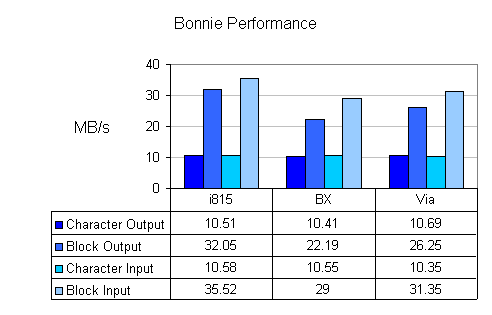Linux Pentium III Chipset Comparison
by Jeff Brubaker on December 18, 2000 12:00 PM EST- Posted in
- CPUs
Disk Performance: Bonnie and Hdparm Benchmarks
We will start with the Hdparm benchmarks because it is perhaps the most ubiquitous disk tool for Linux users. Hdparm provides the mechanism for specifying disk transfer modes used by the kernel. Further, it can test the throughput for both buffered disk reads and cache reads and writes. These tests were conducted using the buffered disk read test, thus measuring actual disk throughput.

We had figured that the Intel 815 and VIA Apollo Pro 133A chipsets would have an advantage over the BX due to their support for higher speed UltraDMA interfaces, which was demonstrated, but that in itself was not enough for the VIA board. The VIA, running at ATA/66, performed only 3.5% faster than the BX chipset despite having the higher performance rating. The Intel 815 cleaned up, performing 52% faster than the BX and 46% faster than the VIA Apollo Pro 133A.
Next up, we will examine the results of the venerable UNIX disk benchmarking program, Bonnie. Bonnie has been around for a long time and is respected, simple and wide spread. These results can be compared against lots of different machines at various locations on the web.

The block transfer modes are the important ones here, as they are limited more by the chipset than by file system. Yes, Bonnie works at the file system level while Hdparm does not. Again, we see the Intel 815 chipset dominating, but by a lesser margin than in the Hdparm benchmarks.










0 Comments
View All Comments